Walk, Eat, Repeat – Seoul
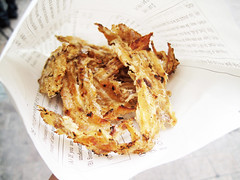 |
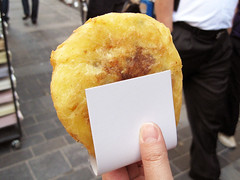 |
 |
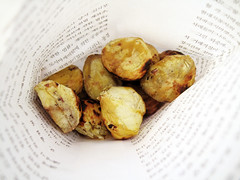 |
Korean people love to snack. It’s a snacking culture. You eat not because you’re hungry, but your mouth is bored. Walking around in Seoul, there’s a vendor or two on every street. (Remember the bbopki post?) I love it! The most popular, and most well-known, street food is probably ddukbokki (떡복기, rice cakes in a spicy sauce), but I’ll be posting about that next time. This post will concentrate on some of my other favorite street snacks: roasted chestnuts, hodduk (호떡, sweet pancakes), jeepoh (쥐포, dried file fish), and gohguma mattang (고구마맛탕, candied sweet potatoes), oh my!
Chestnuts (밤) are of one my favorite wintertime snacks. In Korea, they have charcoal roasted chestnuts everywhere as soon as it starts to get colder.
I’ve seen roasted chestnuts in Lucerne, Rome, and also at a few rare carts in New York, but I like the chestnuts in Seoul because the chestnuts come peeled! It makes eating while walking easier. I got these chestnuts (KR ₩5000/US $4.33) right in front of the National Folk Museum. The chestnuts were nicely charred, but weren’t as soft or as sweet as I would have liked since it wasn’t officially chestnut season. Nevertheless, the chestnuts made for a good snack as we did the tourist thing at the museum.
Hodduk, a sweet pancake usually stuffed with brown sugar, walnuts, and cinnamon, is my favorite sweet street snack. While in Korea, I had two different kinds of hodduk. The first was a deep-fried version in Insa-dong made with sticky rice (찹쌀) flour, corn flour, brown sugar, and walnuts. Deep-fried, it was super crunchy and greasy on the outside, yet still chewy on the inside. Be careful when eating hodduk though. The first few bites were kind of harmless with only a little bit of caramelized syrup action, but towards the middle, potentially dangerous sugar matter lay waiting to maim, disfigure, and/or send you to the dry cleaner’s. It’s best to lean forward when eating fried hodduk. Then in your clean shirt, you can scoff at all the tourists with the brown gunk all over their clothes. Haha, I wouldn’t really do that. 😉
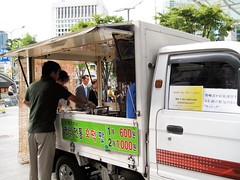 |
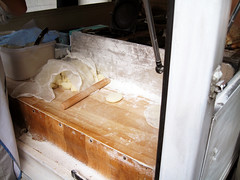 |
 |
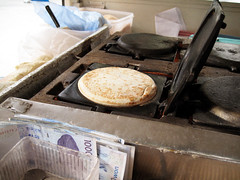 |
The next day, while David and I were walking around Myeong-dong after feasting on dak galbi (닭갈비, marinated spicy chicken) fried rice for lunch, we happened to see every other person walking around with hodduk. “Oh my god, I want that!,” I screamed. To which David replied, “Geez, aren’t you full?” Considering we’ve been dating for four years, I’m not sure why he bothered to ask, so I just ignored him and concentrated on the more important matters at hand: finding the source of the hodduk. Minutes later we came upon the hodduk truck; it had a rolling pin in back, and no one twittering in sight. Hodduk number 2 showed promise.
My second hodduk (KR ₩600/US $0.52) in Seoul, although not fried, was even more delicious than the first. The hodduk is freshly rolled in the back of the truck, supposedly with nine different types of flour, including ginseng, and kneaded with seven different ingredients. Once kneaded, the disc of dough is placed in a rotating metal griddle until it puffs up and reaches a toasty golden brown.
There isn’t much inside the hodduk, but it’s simple and delicious. The baked version is crisp and light with a thin schmear of sweet sugary loveliness.
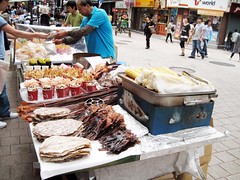 |
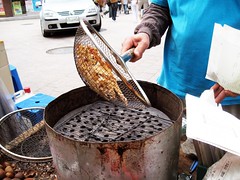 |
In Myeong-dong, we also ran into a man selling all sorts of dried seafood. There was dried squid, filefish, long octopus tentacles, I was in heaven. I’m a big fan of dried ojinguh (오징어, squid) and jeepoh (쥐포, filefish). I asked the nice man which one was the tastiest, and he told me to get the shredded jeepoh (KR ₩3000/US $2.60), which by the way, is David’s least favorite (jeepoh in general, not just the shredded variety). They sell jeepoh at the Korean supermarket in the states, and every few weeks I buy a pack, and cook the individual pieces on top of the stovetop or in the toaster. Sweet and salty, it makes for a nice snack with a cold beer. Dipped in gochujang, it’s even better. However, never having smelled jeepoh before he met me, the first time I made it at home, David begged me to “please never ever make it again.” Of course, this prompted me to be more clandestine in my jeepoh making. However, no matter what, he always knew when jeepoh making had gone down, and would scream, “Did you eat jeepoh?!,” as soon as he walked in the door. After all these years though, he’s come to accept it, and now jeepoh is allowed at home as long as I don’t use the toaster. Strangely, it seems he’s not partial to remnant jeepoh odors permeating into his morning toast.
Anyway, before presenting the jeepoh into my eager hands, the dried seafood man warmed up the filefish over a miniature burner so it became nice and soft. Warm and partially shredded, the jeepoh was much easier to gobble up in record time. Alas, David claimed it smelled powerful, but in a country full of jeepoh lovers, he really couldn’t complain. In fact, to David’s horror, Joo Hyun and I snacked on some leftover jeepoh with our patbingsu (팥빙수, shaved ice) and yogurt ice cream later that night.
However, before we disgusted David that night, I also ate some candied sweet potatoes (KR ₩2000/US $1.33) courtesy of Joo Hyun. When she came to meet us at Myeong-dong, she already had a little container of sweet potatoes for me in her bag. Isn’t she wonderful?! According to the sweet potato stand, the candied potatoes were healthy, or in Korean lingo, “well-being” food. Considering the wedges were covered with a hard sugary shell and oiled up so they wouldn’t stick together, I can’t imagine this to be true, but I ate them all nonetheless. They were delicious. Healthier than eating candied lard perhaps, but healthy? Not a chance.
This is just a sampling of what you can eat on the streets in Seoul. There were corn dogs, dduk stuffed sausage skewers, blood sausage, and so much more food I didn’t have time and room in my stomach to eat. Joo Hyun, Soo Hyun, and I always joke we need two stomachs to eat as much as we want. In Korea, I would need an extra one soley for the street food.
Chestnut Table
In front of the National Folk Museum (southeast corner)
Samcheongdong-Gil 35, Jongno-Gu,
Seoul, South Korea (map)
Hodduk Truck
Dried Seafood Table
Candied Sweet Potato Stand
@ Myeong-dong
Fried Hodduk Cart
@ Insa-dong

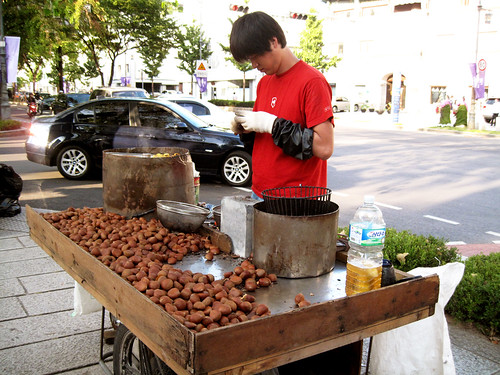



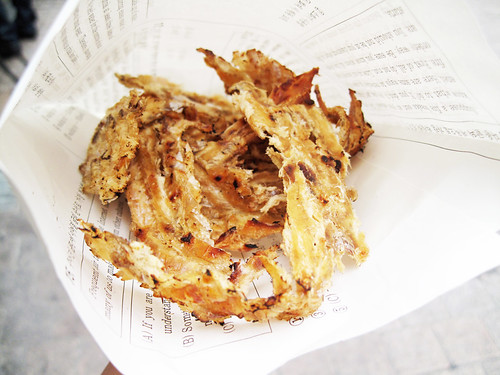
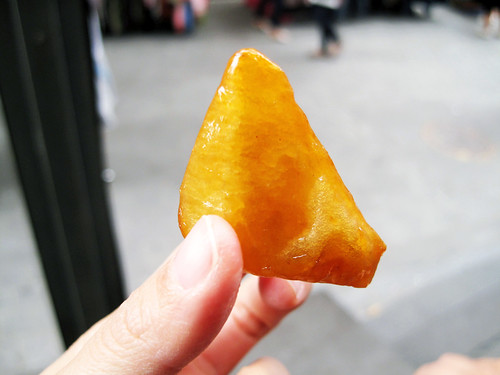
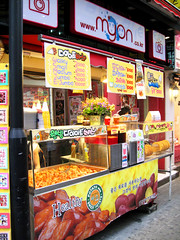











I love reading your blog because it reminds me of Asia :D. There’s something really similar to hodduk in Taiwan, except it’s filled with sesame paste, or peanut paste.
Also wanted to add that I love jeepoh (completely did not know the name until now). I’d buy bags of it at M2M… except I never combined it with dessert…
@Nicholas – Do they sell the sheets of jeepoh (filefish) at M2M? (The sheets should look like the things on the lower left corner on the dried seafood table pic.) They usually don’t sell shredded jeepoh here, just shredded squid.
They did as of last year, I haven’t been since my dorm moved to the other side of campus. Even then, it was hit or miss. I’ve learned to make do with shredded squid though haha.
Which is better, Korean street foods, or Chinese street foods? Try to give an unbiased opinion :).
I’m Chinese and I still say Korean street food. There’s no beating tteokbokki.
@someguy & @Nicholas – I would have to say Korean between the two, but I recently saw pics of street food in Malaysia from a coworker, and I think they may have an edge. Anyone been to Malaysia?